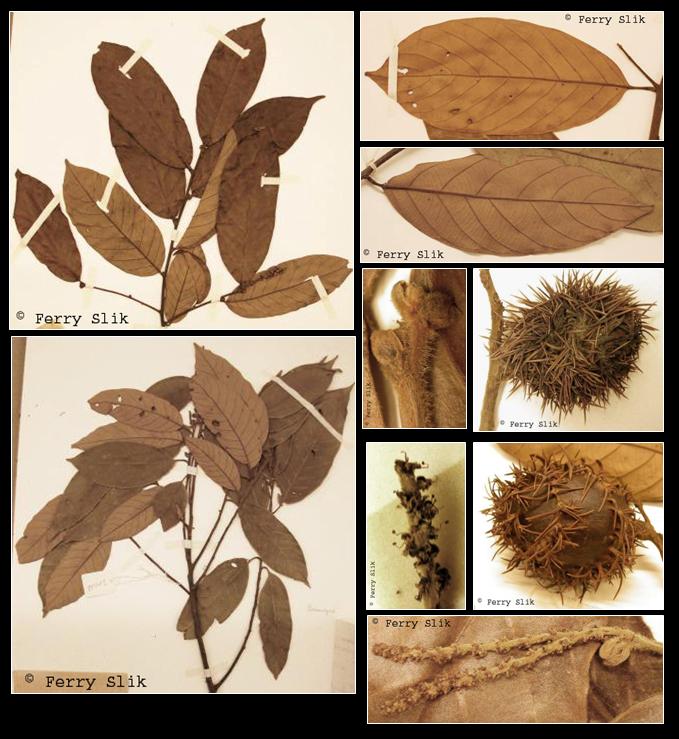Castanopsis hypophoenicea (von Seemen) Soepadmo, Reinwardtia 7 (1968)
Latin for 'purper coloured lower surface', referring to the lower leaf indumentum.Synonyms
Castanopsis dispersispina Merr.
Lithocarpus hypophoenicea (von Seemen) Barnett
Quercus hypophoenicea von Seemen
Diagnostics
Tree with buttresses. Bark smooth to finely fissured. Twigs densely hairy when young, remaining sparsely
hairy when older, psrsely lenticelate. Stipules ca. 4 mm long. Petiole 5-15 mm. Leaves alternate, simple,
up to 15 by 5 cm, penni-veined (11-13 veins), hairy below. Male flowers ca. 1 mm diameter, green-yellow,
placed in racemes. Fruits ca. 83 mm long, green-yellow-brown, nut completely enclosed by cupule with
long, branched spines, 1-2 cm long.
Description
Tree, 12-38 m by 10-71 cm diameter; buttresses up to 1.8 m tall, 1 m out; bark surface grey-brown,
smooth or finely fissured. Branchlets initially densely set with yellowish brown stellate and simple
tomentum, later subglabrous, smooth or finely fissured, or sparsely lenticellate; terminal bud
ovoid, 3-5 mm, scales ovate. Stipules ovate-acute, 3-5 mm. Leaves thin-coriaceous, elliptic-oblong,
(6-)10-15(-19) by (2.5-)4-5(-7) cm, entire, discolorous, above glabrous except the midrib and
veins, dull or glossy, greyish green or chocolate brown, underneath with a dense cover of yellowish
brown, adpressed stellate hairs and simple long hairs; base rounded and abruptly acute or cuneate,
sometimes asymmetrical, apex bluntly acute or 1-1.5 cm acuminate; midrib and nerves prominent
beneath, flattish or impressed above; nerves (9-)11-13(-15) pairs, parallel, ascending, at an angle
of 60-70 degrees, arcuating but not anastomosing near the margin; reticulation dense, fine, subscalariform,
distinct beneath; petiole 5-15 by 2 mm, densely stellate-tomentose, glabrescent, thickened and rugose
at base, adaxially flat or shallowly furrowed. Male rachises 5-10 cm, in lax paniculate clusters;
bracts and bracteoles ovate-lanceolate, 0.7-1 by 0.7 mm; male flowers in clusters of 3; perianth deeply
incised, lobes 6, ovate, 1.5-2 by 1-1.5 mm, stamens 10-12, filaments 3-4 mm, anthers 0.25-0.30
mm long, pistillode subglobose, l.5-2 mm diameter. Female and mixed inflorescences c. 11.5 cm long;
bracts and bracteoles ovate, c. 1 by 0.5 mm. Female flowers solitary along the rachis; perianth lobes
acute, c. 1 mm across; staminodes 10; styles conical, recurved, c. 1.5 mm long. Ripe cupule ovoid-
ellipsoid, sessile, 7-10 by 5-7 cm; wall woody, 2-3 mm thick; spines much branched, needle-shaped,
1-2 cm long, regularly set in more or less 6-8 curving lines with space in between the rows; dehiscence
apparently irregular. Fruit solitary, ovoid-ellipsoid, 4-6 by 3-5 cm, wall woody, rugose, 3-7 mm thick,
completely adnate to the cupule; adaxially flat. [from Flora Malesiana]
Ecology
In undisturbed to slightly disturbed mixed dipterocarp and sub-montane
forests up to 1300 m altitude. Mostly on hillsides and ridges, but also along
rivers. Usually on sandy soils.
Uses
The fruit is edible.
Distribution
Borneo.
Local names
Borneo: Bangan, Bedayang, Berangan, Berangan bo, Bibi, Pedayang, Wau.
